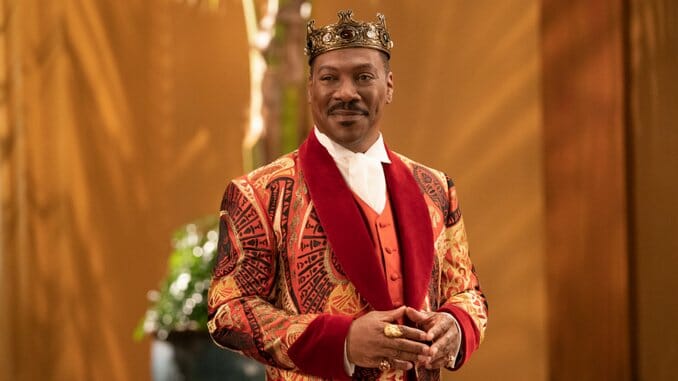Coming 2 America Will Make Your Soul Glow

Coming 2 America effectively uses the legacy of Zamunda to expand the narrative space not only of the classic original, but for Black diasporic affinity at large. At the end of the 1988 romantic comedy, the royal marriage of Akeem Joffer (Eddie Murphy) and Lisa McDowell (Shari Headley) further symbolically enmeshed the interconnected experience between African-Americans and Black Africans. In this sequel, the legacy of that union is explored through the gendered opportunities of Prince Akeem’s lineage and the pressure he faces to determine his royal successor—all while appeasing the tyrannical leader of Zamunda’s neighboring country Nextdoria, General Izzi (Wesley Snipes). Coming 2 America is an exciting follow-up that’s ensemble cast and increasingly complex musings mostly outweigh its shortcomings.
In present-day Zamunda, Prince Akeem enjoys the company of his wife, his three badass warrior daughters and his dear albeit mischievous dude-in-waiting Semmi (Arsenio Hall). But when dying, nearly expired King Jaffe Joffer (James Earl Jones) reiterates that Akeem’s eldest daughter, Princess Meeka (KiKi Layne, Beale Street! Beale Street!) will not be eligible to inherit the throne because she is a woman, Akeem and Semmi return to Queens to find Akeem’s long-lost bastard son, Lavelle Junson (Jermaine Fowler). Of course, hijinks ensue along the way. Semmi and Akeem must fumble around a new New York stuffed less with mustard-colored cabs and more with rideshares. They become acquainted with an increasingly gentrified Queens, visit some familiar friends and meet new members of Akeem’s extended family as they court Lavelle.
This film’s greater comedic elements come from these familiar moments of cross-cultural tension and new intergenerational differences. Tracy Morgan, who plays Lavelle’s lovingly brash Uncle Reem, lightly spars with Semmi and Akeem about how to properly mentor Lavelle during his princely training. When Lavelle struggles to embody the Zamudan royal gait, Uncle Reem helps him develop his high-roller, more authentically Lavelle walk. What is a crisis of personality is remedied through a pep-talk and a silly sequence. Moments of tension or confusion are enhanced with humor rather than the funniness undercutting the film’s dramatic elements. This manages to make Coming 2 America feel light while still centering familial strain and heavy diasporic conflicts that persist between differing Black communities at the heart of the film. When Lavelle finally arrives in Zamunda, he reckons with what it means to now know his father, to potentially become a prince and to be legibly African. It’s a compelling and complicated emotional journey that forces Lavelle—like his father before him—to navigate his Blackness in a new, vibrant Black environment.
And Coming 2 America certainly showcases an undoubtedly vibrant Black environment. Between the film’s mixed Afrobeats, R&B and rap soundtrack, sweeping nature shots of Zamundan brush and the colorful print-heavy fashion flare of Zamundan attire, the sights and sounds of Coming 2 America are ensnaring to the senses. There are high-energy dance sequences and parties galore that showcase Ruth E. Carter’s superb costuming choices and Craig Brewer’s energetic direction.
While the pressures to inherit the decadence and glory of Zamunda results in some impressive dramatic delivery from Fowler, his comedic chops shine through in every scene and anchor the film in a grounded place of play. Lavelle has bursts of frustration, no doubt. But he also runs from a CGI lion and bonds with his younger sisters. It is incredibly entertaining to watch Fowler’s talents—showcased in earlier films like Sorry to Bother You and Judas and the Black Messiah—given space to shine alongside the likes of comedic titans like Leslie Jones, Murphy and Hall.
-

-

-

-

-

-

-

-

-

-

-

-

-

-

-

-

-

-

-

-

-

-

-

-

-

-

-

-

-

-

-

-

-

-

-

-

-

-

-

-








































